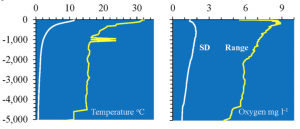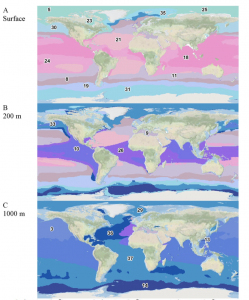Costello, M. J., Basher, Z., Sayre, R., Breyer, S., & Wright, D. J. (2018). Stratifying ocean sampling globally and with depth to account for environmental variability. Scientific reports, 8(1), 11259.
The ocean is a gigantic environment, covering more than two thirds of the Earth’s surface. It is so big, the word “ocean” has come to describe something that is very large or unlimited in size: Love as deep as the ocean, a drop in the ocean, an ocean of people. Besides being an evocative part of our lexicon, the ocean is also a critical component of eco- and climate systems at just about every scale (check out any of the other articles on this blog!).

Measuring and monitoring the world’s vast seas is a highly involved, enormous task. How do you go about observing a body of water so immense and complex? There are many dedicated scientists, using an array of methods and tools, attempting to do so. But even with an army of researchers and a navy of vessels, no one could ever hope to capture the whole picture. Researchers necessarily have to economize and deploy their limited resources in a principled way.
Like many other oceanographers, Dr. Mark Costello of the University of Auckland recognized that there is no realistic way that the oceanographic community could densely sample the ocean at every point. He and several colleagues sought a scientifically grounded framework to manage resources for ocean observation. They hope that a principled approach, applied by the community at-large, could facilitate better ocean observing. Such a scheme would need to take into account the range of scales that phenomena occur on: El Niños take place over the entire Pacific Basin on a roughly 10 year cycle. But eddies can mix things up over a few kilometers and last a matter of days to several months. Further complicating observation efforts is that these processes all interact with each other in subtle ways.

In their recent Scientific Reports paper, Costello and his team proposed that ocean sampling be stratified, or divided, based on longitude, latitude, depth, and time. The basic insight of their approach is that the time-scale of change in the ocean is different depending on where you are looking. Physical and chemical shifts in water at the ocean surface, for example, happen more rapidly then in the midwater. Costello makes clear that this does not mean that one zone is more important than another. His point is rather that more slowly varying waters do not need to be sampled as frequently as those that turn over quickly.
Consider the global average of temperature, oxygen, and current speed as a function of depth (fig. 1). Both parameters fluctuate rapidly in the upper 1000 meters of the ocean, but are stable almost all the way to the bottom. There is, of course, huge amounts of regional variability. But, in the aggregate, the middle of the ocean is pretty quiet.
Costello and his team analyzed a suite of such environmental parameters to propose dividing the ocean into Ecological Marine Units (EMUs). The group suggests that the ocean can be separated into 37 distinct EMUs, each with a unique physical and chemical signature (fig. 2). Costello makes no particular prescriptions on how to design studies or appropriately deploy monitoring resources in these regions. He merely proposed them as a tool and guiding principle.
The ocean is a challenging part of the world to study – it is vast, deep, difficult to access, and expensive to sample. It behooves the scientific and policy-making communities to carefully consider how to use their resources – financial and human – to best study the sea. We do not want to miss anything, but we also cannot observe everything, all the time. Costello’s EMUs might not be the ideal way to find the balance between desire and reality. But it is a start. And one that could lead us in the right direction.
Eric is a PhD student at the Scripps Institution of Oceanography. His research in the Jaffe Laboratory for Underwater Imaging focuses on developing methods to quantitatively label image data coming from the Scripps Plankton Camera System. When not science-ing, Eric can be found surfing, canoeing, or trying to learn how to cook.


